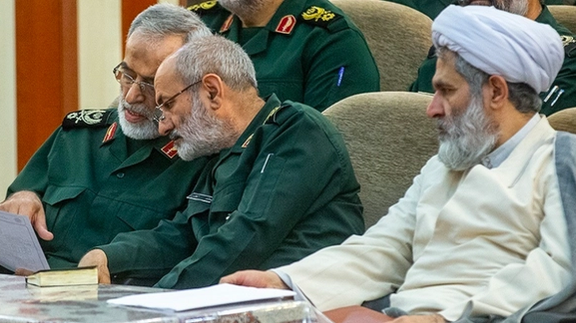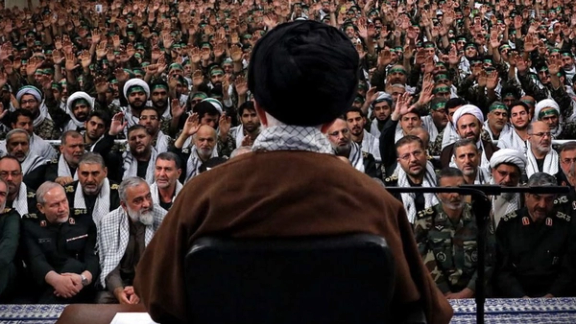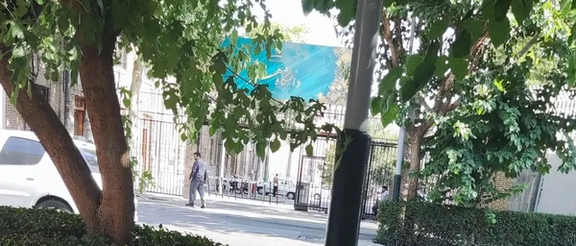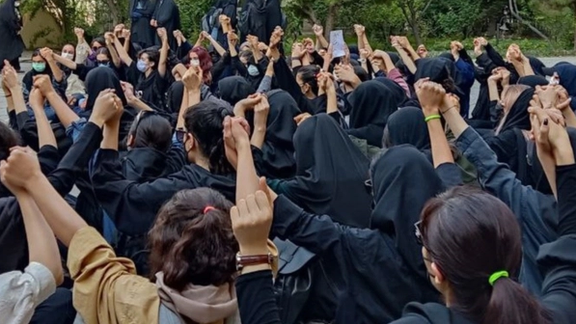New Zealand Sanctions 18 More Iranian Officials

In response to the regime's crackdown on protesters, 18 Iranian officials have been banned from travelling to New Zealand.

In response to the regime's crackdown on protesters, 18 Iranian officials have been banned from travelling to New Zealand.
New Zealand's Foreign Affairs Minister Nanaia Mahuta announced on Monday a third tranche of sanctions saying it was a message to Iran that the country would not tolerate denial of human rights and violent suppression of protests.
“Our first and second tranches of travel bans sent a message to Iran that Aotearoa New Zealand will not tolerate the denial of basic human rights and the violent suppression of protests in Iran, and this third tranche reiterates that same message,” Nanaia Mahuta said.
“Despite international pressure, the Iranian regime has continued that severe and excessive repression of peaceful demonstrators since Mahsa Amini’s death, including the unconscionable execution on the 19th of May of three people in connection with their role in the protests.”
This brings the total number of banned officials to 55, following earlier bans on 37 Iranians associated with the death of Mahsa Amini, a 22-year-old who died after being detained for wearing her hijab "improperly".
A further 11 officials and seven Iranian entities have also been banned from travelling to New Zealand for having manufactured and supplied drones to support the invasion of Ukraine by Russia.
"This is not the end of our efforts with Iran. Additional individuals and further measures remain under consideration given the Iranian state's ongoing egregious abuses of human rights," added Mahuta.

The head of the Revolutionary Guard's intelligence claims secret services of about 20 countries were involved in supporting Iran's popular protests in 2022.
Mohammad Kazemi, who took over from Hossein Taeb in July 2022, made the remarks in an interview format with Khamenei.ir, the website of the Supreme Leader. It was his first media appearance since his appointment to Iran's most fearsome intelligence and domestic repression outfit.
The brigadier general accused 18 countries that supported “the riots” across the country sparked after the death in custody of 22-year-old Mahsa Amini in police custody. He named the US, the UK, UAE, Saudi Arabia, France, Germany, Canada, Belgium, Austria, Albania, Australia, Iceland, Italy, Kosovo, Norway, Bahrain, New Zealand and Israel.
Kazemi's claim of so many countries conspiring against the Islamic Republic topped even other regime hardliners who all along have attributed the protests to foreign "enemies." The conspiracy theory, as is usual in Iranian politics, first came from Khamenei and his loyal officials began repeating the accusation.

If Kazemi's claim were true, it would imply that about 20 countries want the Islamic Republic to collapse as the protests – which are somewhat still ongoing in forms of strikes and periodic gatherings – have been the boldest challenge against the clerical autocracy.
This would hugely expand the Islamic Republic’s definition of “enemies", which until now was used to refer primarily to the United States and Israel, and sometimes to their allies. Now, every entity and individual who has expressed support for the anti-regime protests is labelled an enemy.
Government forces killed more than 500 civilians and arrested more than 20,000 people until February, and more persecution and arrests continue, while Khamenei has boasted of defeating enemy plots.
The IRGC-IO commander also claimed that the intelligence agencies of Israel and the United Arab Emirates "met periodically in an Arab country" to discuss how to support the protests in Iran. In addition, he referred to Saudi Arabia and Bahrain as hostile countries, which seems to contradict the regime's new foreign policy of rapprochement with Riyadh and its Persian Gulf allies.
Adding to the odd allegations, Kazemi said that by the end of the unrest, the CIA called to form a joint taskforce with Israel’s Mossad and the UK’s MI6 to “re-launch the project to assassinate Iranian scientists, especially in the nuclear, aerospace and military fields.”
He also claimed that the intelligence agencies recruited European as well as non-European nationals, including Afghans, Pakistanis, and Iraqis to collect information and documents about the unrest, adding that 40 nationals of one of the neighboring countries and Europeans were arrested in this regard.

After the removal of Iran-based marketplace app Divar from Google Play, three more major Iranian apps have been suspended.
The removal of Digikala, Tapsi and Ap is believed to have taken place due to conforming with US sanctions against Iran.
Several days ago, Divar, a popular online shopping program, was removed from Google Play for being Iran-related.
“Products on Google Play may be subject to United States’ and other jurisdictions’ export control and sanctions laws and regulations,” read Google’s email.
It is not the first time this has affected the apps. Ridesharing app Tapsi and e-commerce platform Digikala, as well as Snap, were removed from Google Play recently but following legal proceedings, were brought back to the platform.
This week, Divar announced they are taking legal steps to contest the decision.

Various civic and popular organizations in Iran are joining the chorus of support for students in Tehran who have been staging protests against stricter hijab.
Support for defiance of stricter hijab by students who staged a sit-in against wearing a hood-like head covering Wednesday and condemnation of violence against them is growing.
Students in several other universities across the country and various social and political groups have expressed solidarity with the students at University of Art in Tehran.
A statement released by a group of Tehran University students Saturday told the authorities that "the policy of maximum repression” they have adopted in universities will ultimately fail “like other forms of repression” used against Iranian people.
Protesting students at the University of Art and their supporters released a short statement Sunday, which addressing the authorities, said students had “nothing to tell them except one word: NO!” and insisted that they would continue “to fight for freedom”.
Male and female plainclothes agents abducted at least ten students from the campus on Saturday and took them to an unknown location without any interference from police special forces who were present around the university. Student sources said all but two of the detained students were freed Sunday.
Students had been protesting new rules that require women to wear a pullover headscarf with stitched front (called Maghna’e in Iran) which is like a nun’s coif, completely covering the head and the neck. Failing to comply, the university has said, would result in suspension.
According to the popular Telegram channel of the National Student Unions Council, at about 2:30 am Thursday, Hamzeh Borzouei attacked a group of about fifty students who had begun a sit-in protest.
Iranian Writers’ Association in a statement published Friday supported the students’ action and said authorities and those who carry out their orders of repression will be responsible for any harm to the students.
In recent months, security and intelligence organs have increased pressure on students for hijab, presumably to stop the growth of the anti-compulsory hijab movement in universities across the country and suspended dozens of students.
In June Sepideh Rashno, a 29-year-old anti-compulsory hijab activist, said in an Instagram post that Al-Zahra University of Tehran had suspended her for two semesters. Rashno was tortured in detention into making a televised “confession” and condemning other activists as well as expressing regret for her confrontation with a hijab enforcer on a city bus in July last year and posting a video of the incident on social media.
Authorities have also been trying to isolate artists who supported the Woman, Life, Freedom movement or defied hijab rules.
Entekhab news website Saturday published the image of a letter from an official regulating the film industry, Habib Ilbeigi, to the chairman of film producers’ union in which filmmakers are ordered not to employ actors and others who have defied the hijab “or personally face the consequences” including refusal of a screening permit.
Police chief, Ahmad-Reza Radan, said earlier this week that the government of President Ebrahim Raisi has approved extra funds to install more hijab surveillance cameras and that four special task groups have been launched to continue the war against hijab rebellion including one that will monitor social media platforms to identify those who publish photos of themselves without hijab.
Anti-hijab and anti-regime protests erupted in Iran in September 2022 after Mahsa Amini, a young woman was arrested in the street by the notorious ‘morality police’ and received fatal head injuries during here detention and later died in hospital.

The regime has refused to release the body of a young man security forces killed last week unless his cousin, the mother of another dead protester, turns herself in.
According to exclusive information obtained by Iran International, Mahmonir (Zaynab) Molaei-Rad, the mother of Kian Pirfalak, a nine-year-old boy murdered during protests in November, has been summoned by the intelligence organization of her hometown Izeh, in the oil-rich province of Khuzestan, for Sunday morning.
It is not clear what fate awaits her at the intelligence agency’s office but it is likely the regime hopes to silence her in exchange for the body of her dead cousin. Authorities have told the bereaved family that they would release the body on Saturday but instead they arrested more members of the family.
Pirfalak died when security forces fired at his family car for no apparent reason. Almost overnight, the child became a symbol of regime brutality on social media and during street protests.
His mother’s cousin, Pouya Molaei-Rad, was killed as security forces opened fire at his car last Sunday as people of Izeh tried to gather at the cemetery to commemorate him on his 10th birthday.
Regime’s hardliners have been blaming Kian’s mother for the incident. Vocally against authorities since her son was killed, as Perfalak was laid to rest on November 18, his mother made a fiery speech at the graveside, conveying a strong message of protest against Supreme Leader Ali Khamenei who she held directly responsible for her son’s killing.

Iranian students have spoken out against brutal crackdowns taking place at Tehran University of Art where students are protesting draconian hijab laws.
An unknown number of students at the fine arts institution in Tehran have been staging a sit-in against stricter hijab rules inside the university premises since Wednesday, with many seriously injured by the campus security forces on Thursday and several others arrested by plainclothes agents on Saturday.
The sit-in began after the authorities announced new rules for the Art University that require girls to wear a pullover headscarf with stitched front (called maghna’e in Iran) which is like a nun’s coif, completely covering the head and the neck. Failing to comply, the university has announced, would result in suspension.
The College of Arts students published a statement condemning “the gender apartheid” and the violent acts against the protesting students. The head of campus security, Hamzeh Borzouei, himself attacked a group of about fifty students who had begun the sit-in protest and injured at least five of them.
Following the incidents, several separate statements were issued online by students from institutions including Allameh Tabataba'i University, Tarbiat Modarres University and Shahid Beheshti University in Tehran, vowing to continue protests against the repressive policies.
Expressing solidarity with the students of the College of Arts, one of the statements claimed that "the policy of maximum repression that has intensified in a coordinated manner in universities around the end of the academic year, like other forms of repression, will ultimately fail."